In this Issue
- Apple, Pear: codling moth updates, fire blight post-bloom
- Peach, Nectarine, Apricot: peach twig borer spray dates for some southern Utah locations; green peach aphids
- Cherry: monitor interior leaves for powdery mildew; treat for cherry fruit fly at salmon blush color
- Berries: raspberry horntail prevention coming up
- Other Information: thinning fruit, beneficial spotlight-lacewings
APPLE, PEAR
Codling Moth
updated codling moth treatment dates
View a pdf of the spray timing table. Be sure to read the instructions at the top of the page, for how to read the table.
Treatment
- See this post for spray options for backyard growers (scroll down to Codling Moth heading and see table).
- Options for commercial growers.
Fire Blight – Post-Infection
inspect fruit clusters starting 2 weeks after full bloom for infections
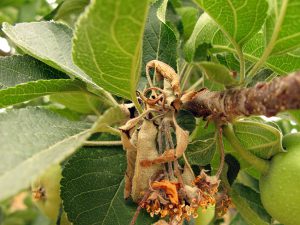
Symptoms of fire blight infections will start to appear 2 to 3 weeks after full bloom. It is important to monitor your apple and pear trees every week. Look for wilted leaves, and fruit clusters that appear shriveled and brown.
Post-infection Treatment
- Prune out all diseased plant parts as they are found. This will not only prevent the infections from expanding into the tree, but will also reduce the source of bacteria in the area.
- For infections that are caught early, remove twice the length of the visible symptoms.
- For infections that are caught late (that have expanded beyond the fruit cluster), it is important to make the pruning cut 10 to 12 inches beyond the visible symptoms.
- Prune in dry weather only. To be safe, wipe pruners with disinfecting wipes between cuts.
If moisture is predicted after pruning, remove the debris rather than leaving it in the orchard. If conditions are hot and dry, it is OK to leave the debris on the ground and mow it.
PEACH/NECTARINE, APRICOT
Peach Twig Borer
nearing time to treat in some southern Utah locations
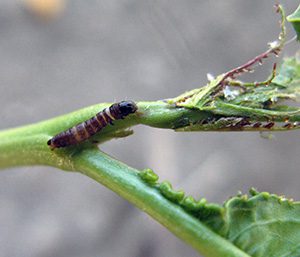
View a pdf of the spray timing table. It shows when to start treating the first generation for a few southern Utah locations.
Peach twig borer affects peaches, nectarines, and apricots. Unlike codling moth on apples, this pest is more sporadic in Utah, and some locations have a low enough population that does not need to be treated. You may need to apply insecticide regularly so that your tree is protected throughout each generation, or, if you have low pest pressure, you can get away with a single (or no) application for each generation (up to 2 well-timed sprays).
Treatment
- See this post for spray options for backyard growers and scroll down to Codling Moth heading and see table. These options can be used for peach twig borer, too.
- Options for commercial growers.
Peach Aphids
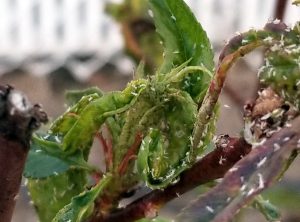
Aphids are appearing on peach, apricot, and other crops. On peach, the aphids are green peach aphid. They overwinter as eggs, and hatched at budbreak. They will spend the next few weeks feeding on the undersides of the foliage, and then migrate away to summer hosts (vegetable plants and weeds).
Treatment
- Residential growers can use Ortho Flower, Fruit & Vegetable (although you may only be able to find it online). This product is slightly systemic, so it will take care of the aphids on the undersides of the leaves. For organic, there is insecticidal soap, but the soap must come into contact with the aphids, and they are tucked tightly within the leaf curls.
- Commercial growers can click here for options.
CHERRY
Powdery Mildew on Commercial Tart Cherry
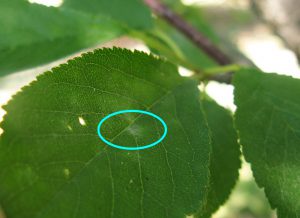
monitor interior leaves for new infections
Cherry powdery mildew lesions may start to show up on tart cherries in the next few weeks. The fungus overwinters as resting spores in fallen leaves, on the orchard floor, or in bark crevices.
Infections on new leaves occurs when spring rains or summer irrigation increases the humidity under the trees, causing the resting spores to release and spread. This pathogen needs 90% humidity and temperatures between 50-78°F for infection to occur.
Leaves, fruit, and fruit pedicels can all become infected. Monitor for the earliest infections on leaves near the trunk, and on the lowest, interior twigs (where humidity is highest).
Sprays are recommended as soon as the first lesions are spotted, because prevention is the best management option for powdery mildew. Continue sprays at 7 to 14-day intervals until growth hardens off.
Commercial growers can find options by clicking here.
BERRIES
Raspberry Horntail
prevent egg-laying by treating for adults
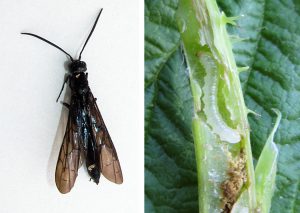
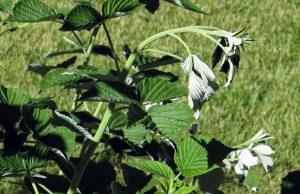
Raspberry horntail is a sawfly that lays eggs inside the tops of raspberry canes. The eggs hatch into larvae that then feed within the upper canes, causing the tops to wilt and die.
Adult horntails will begin emerging from canes that were infested last year, starting May 24 in the warmer Wasatch Front locations to May 30 in the cooler locations.
If raspberry horntail is a problem in your area, an insecticide application to prevent egg-laying should be applied before those dates. Synthetic pyrethroids (GardenTech Sevin or Spectracide Triazicide) or carbaryl are effective. Spinosad (organic) is another option, but unproven.
A second application should be applied 10-14 days later depending on product residual and when bloom time is happening. (Avoid treating during bloom.) In cooler areas, emergence (and treatment) will be about 2 weeks later.
OTHER INFORMATION
Thinning Fruit
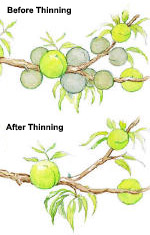
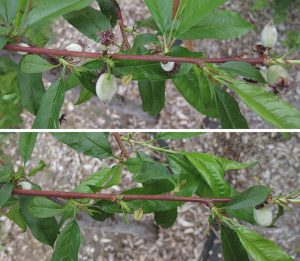
Thinning fruit is very important, and results in the following:
- Improved fruit size and quality. Trees have finite resources and can make fewer large fruit or many small fruit. Reducing the number of fruit early will increase the size of the remaining fruit. When fruit loads are within the ‘carrying capacity’ of a tree the fruit are sweet, juicy, and aromatic (flavorful).
- Flowers for next year. The developing seeds of fruit are rich sources of plant hormones. These hormones cause the fruit to enlarge. They also interfere with the creation of flower buds that will result in fruit the following year. Reducing the number of fruit on a tree this year will allow flower buds that precede next year’s crop.
- Prevention of limb breakage. When trees are overloaded the weight of the fruit can cause limbs to bend beyond their limits resulting in broken limbs.
Apples and pears should be thinned when they are 1/2-inch in diameter. Leave only one fruit per flower cluster and thin clusters so they are no closer than 6 inches apart. In apples, the center fruit (king fruit) will be the largest and should be retained. Remove the side fruit.
In pears, the lowest fruit will be the largest and other fruitlets should be removed. Small scissors can help to remove individual fruit.
Peaches should be thinned so that individual fruit are no closer than 6 inches apart. They are normally thinned by hand by twisting fruit to be removed. Leave no more that 100 to 150 peaches on mature trees. Young trees will have proportionally fewer fruit.
Beneficial Spotlight – Lacewings
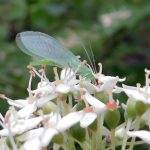
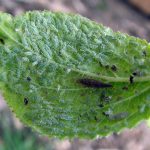
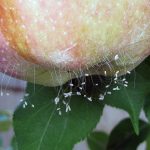
Lacewings are another valuable predator of aphids and other soft-bodied insects (scale, thrips, mites, leafhoppers, etc.). The adults are active at night, visiting flowers or lights, while larvae are often found among aphid colonies all season long.
There are two common lacewings in Utah–the green lacewing and the brown lacewing. Green lacewings are the most common, while brown lacewings are more rarely seen because they prefer wooded areas.
Green lacewing adults have pale green bodies, golden eyes, and are named for their delicate, lacy, wing veins. Females lay eggs that are individually attached to a hair-like stalk which helps protect the eggs from predation.
The larvae resemble tiny alligators. They are flattened, tapered at the tail, and possess prominent mandibles with which are used to grasp their prey. Average development time from egg to adult is about one month.
